I intend to have a conversation with you about some ideas on how to think and plan so that your photos bring an adjacent meaning beyond the mere frozen image that appears in the first and shallowest plane of those who observe it.
In other words, I intend to inspire them to seek to create photographs with deeper layers of meaning. This can be through an image capable of transmitting a narrative, which instigates the observer’s mind to create a temporal sequence of before and after when seeing an image (which is a present, paralyzed moment), or an image loaded with adjacent symbolism, which brings messages in deeper layers than the scene itself considered.
The ability to make an image convey messages in deep layers is truly incredible and very difficult, as a rule, characteristic of artists and demands an enormous cultural background from the photographer. However, that doesn’t mean we can’t try to do it.
I am definitely a long way from being a great photographer and capable of transmitting profound messages through my images, but I try to do this within the limits of my capabilities. The very exercise of reflecting more on a photo while planning it is an exercise to improve our philosophical mind and, above all, our creative capacity.
Therefore, regardless of whether or not you think you are capable of creating great concepts for your photos, start with the first step, try little by little to include something more and this will be a skill that will gradually develop.
In addition to exercise, seeking sources of inspiration is also essential. Inspiration is something that comes from within, but this “birth” of ideas (maieutics, Socrates would say) needs to be assisted by external stimuli that help us channel the best ideas. The arts are excellent forms of inspiration for this, especially when we study all the ideas that our reference artists created when they composed them. Understanding symbols is also essential, after all, it is through their language that an image can say something more.
Before continuing, I also need to warn that a photograph does not end with a good and profound idea, as the idea is always abstract and the photograph is something concrete. This difficult mission of bringing the mental to the visual requires creativity and that this creativity is expressed and enhanced by composition techniques, lighting, color theory, etc.
There is, therefore, an indissoluble symbiosis between creativity and mastery of execution techniques.
These techniques can be divided to explain them didactically, but, in practical exercise, everything is interconnected. In this approach, I will pay more attention to the creative and symbolic process behind some photos I created, but never forget that this is not a process isolated from other photography techniques.
Returning to the proposal, I will share some of my photos and explain the mental process I used behind each of the images. Let’s go to the first image:
First example

The initial idea was to represent a person who is at the beginning of their career but is skeptical of their potential and willing to give up (who has never experienced this?).

This feeling takes us back to the “hero’s journey” and I chose that our hero in crisis would be an apprentice wizard because wizards are symbols of acquiring wisdom through effort over years (the older the wizard, the more powerful).
I gave him with a sad expression. The hat left aside symbolizes the desire to give up. The inclusion of the master in the scene was to represent the help of the apprentice by someone who has been through this before.
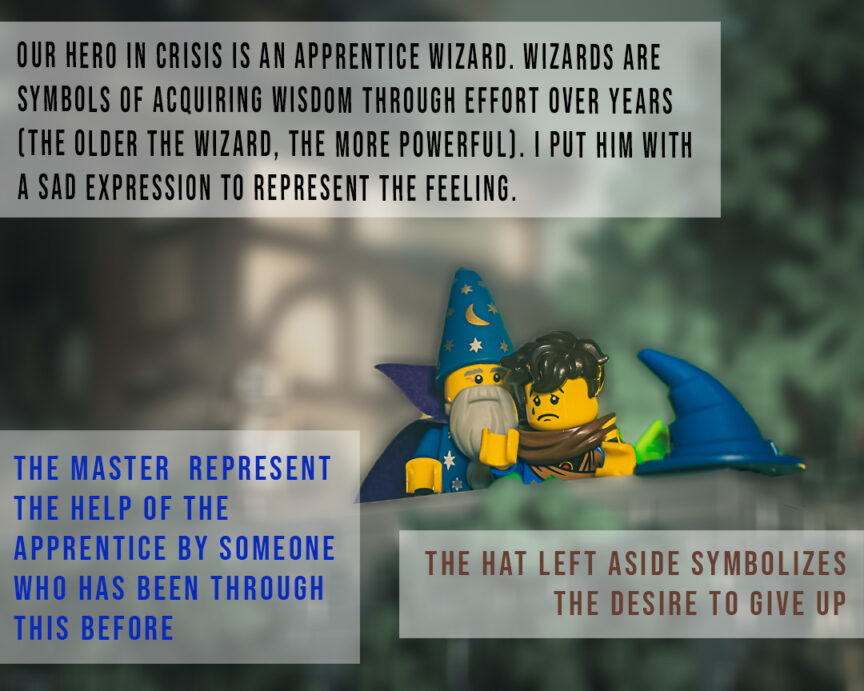
Having established the characters, let’s move on to the setting. The hero is outside his home, at the edge of the land, at the edge of a wall, on the edge of a cliff. This environment represents his mind. Home is the safe place, the comfort zone he has moved away from.

The edge of the wall represents that our character is in a borderline mental state. The outside of the walls is wild and inhospitable (which represents the dense vegetation), like the confused thoughts that torment him.
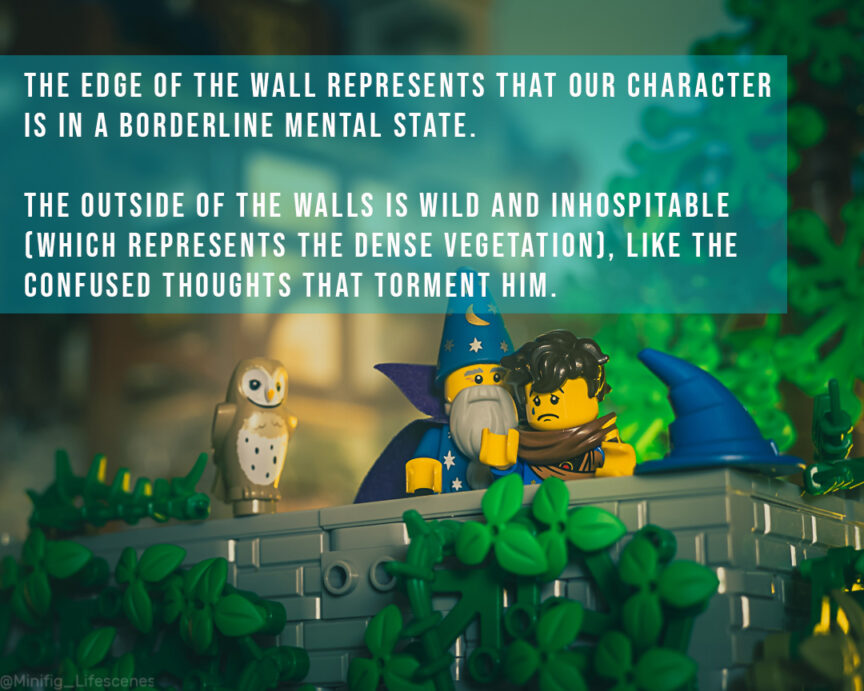
The slightly low angle highlights emotions and shows the unevenness of the ground. The owl was included to fill the void on the left. It triangulates the characters (balance) and can be either a mascot for the magicians or another master secretly helping (let’s remember that owls are traditional symbols of prudence). The tree was placed to fill the background. The elements were positioned using the rule of thirds.

Second example
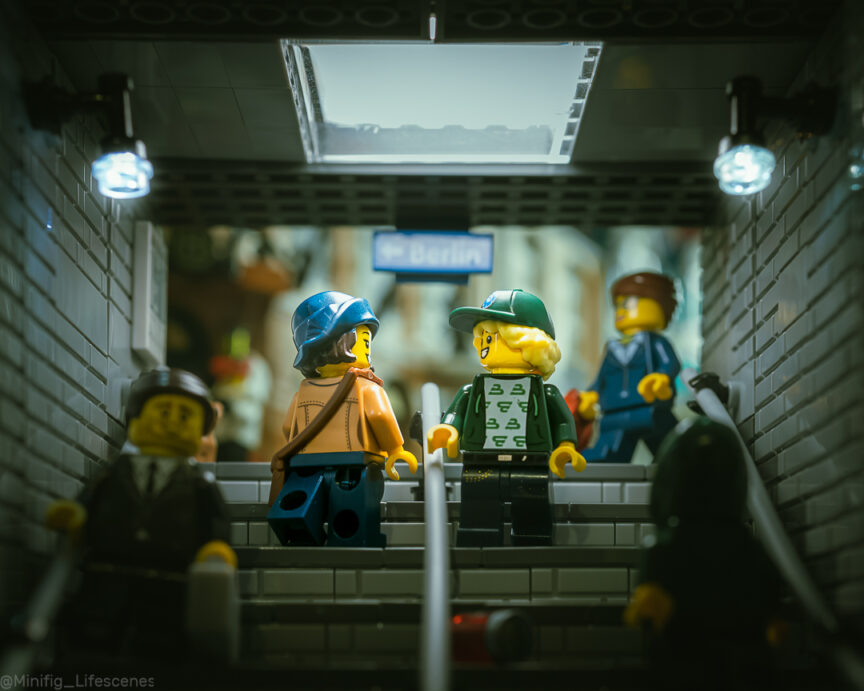
The idea was to portray an exchange of glances, a momentary and fleeting love. Who has never quickly crossed paths with another person, had a momentary exchange of glances, fell in love for a split second, and then carried on with life normally, without even knowing who the other person was? This is the situation I want to portray.
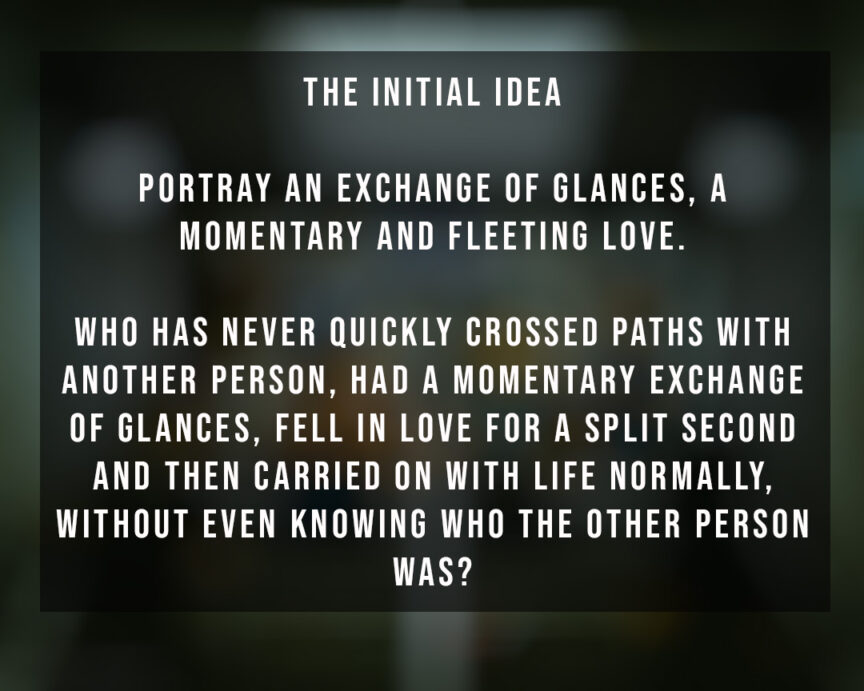
I started by choosing the environment and the best place to portray the intense flow of rushing people is a train station in an urban center, where many people pass each other and no one knows each other.
Train stations are an excellent portrait of impermanence, where everything flows, everything is fleeting, just like the feeling we want to represent in the photo.

The second element is the lovers. I portrayed them both in youthful clothes, to indicate their youth, an age more prone to this feeling.
Both are wearing hats, as a sign of combination, harmony between them. Their gazes are deeply connected and they smile at each other: this is the split second that their eyes meet and magic happens.
The lighting projected by the skylight highlights the characters’ smiles and contrasts with the gray of the season and the cloudy weather. With this, I tried to represent that it is the small everyday emotions that illuminate and color our days.
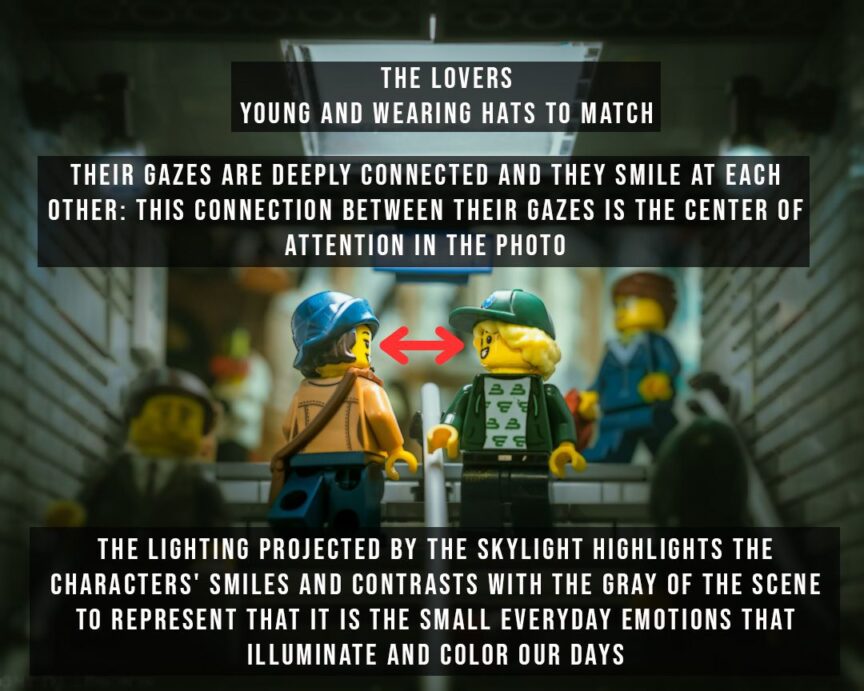
There are other details purposefully included in the image. There are 4 people around the “couple”, although the top character on the left (in a white coat) is almost imperceptible. These people create balance and stability for the image (square shape), along with the station portal that serves as a frame. There is a sequence of horizontal lines that also give stability to the scene.
On the other side, a series of diagonal lines converge in the center and direct the viewer’s gaze towards the “couple”.

Third example

The objective is to portray charity, but demonstrating that people can learn to be more charitable. I want the viewer of the photo to feel that he or she can also be a charitable person, that is, that my photo encourages people to be more sensitive to others.
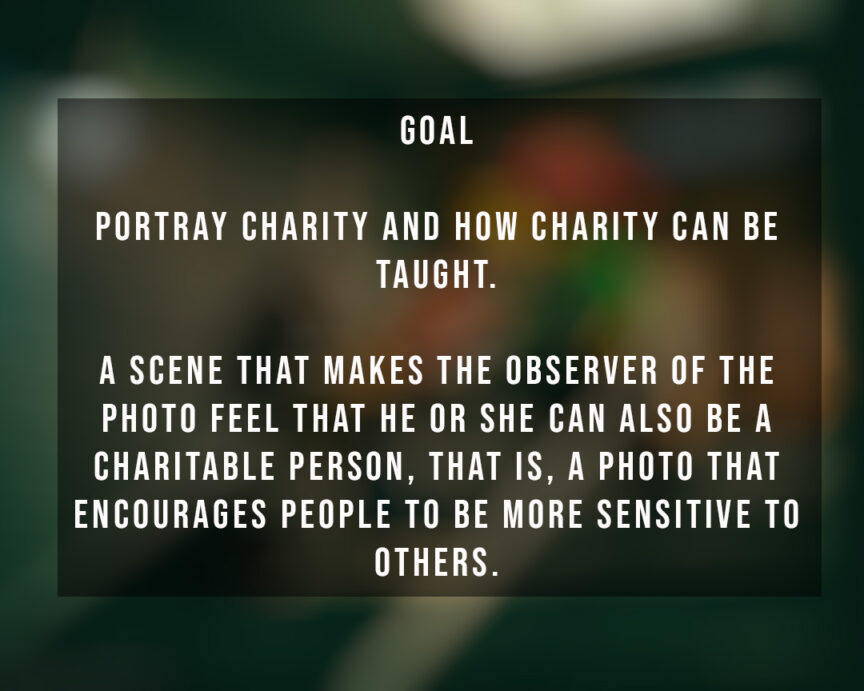
The first image of charity is the act of giving food (primary need) to the poor and the first image for the transmission of values is education from father to son. The scene will be a father who takes his son to donate food to a beggar: father = planner of the action (dressed in a suit to represent maturity); son = executor of the action (with youthful and colorful clothes to represent a lively apprentice); beggar = recipient of the action (with gray rags and a scruffy beard to represent the condition of being in need).
Detail: there is red on the father’s tie and on the son’s cap, a color that represents charity, giving one’s life, giving one’s blood for others. The son’s green color represents hope for a better future generation.
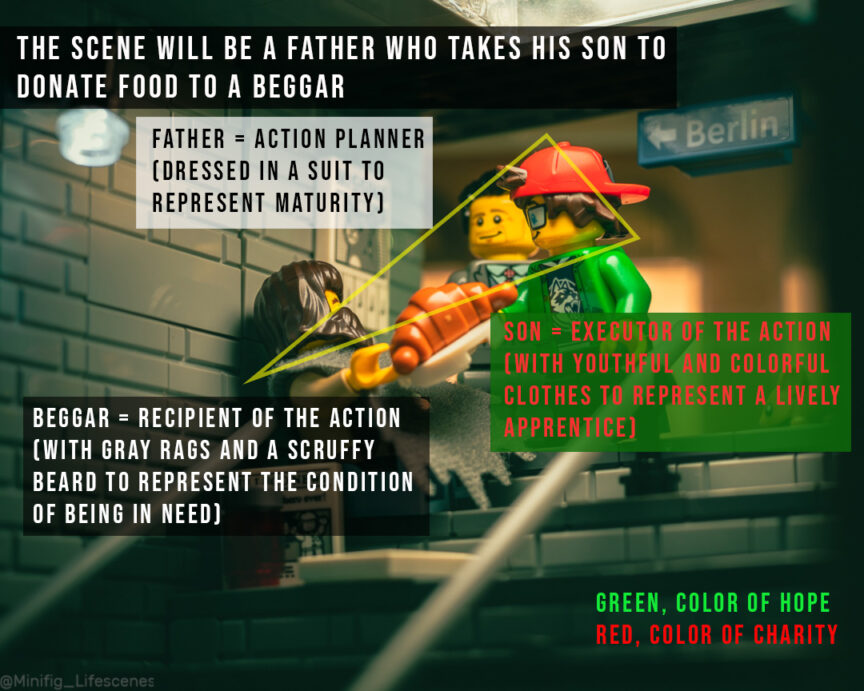
The setting is the same station as the previous photo, but with a different meaning: train stations are dark and dirty at night, shelters for marginalized people.
This shows that the father and son went to the beggar and not the beggar went to them. This shows that good charity is an active action in which the donor must take initiative towards those in need and not be mere passive help. The verticality between the donors and the beggar in the scene represents this active action (downward donation).
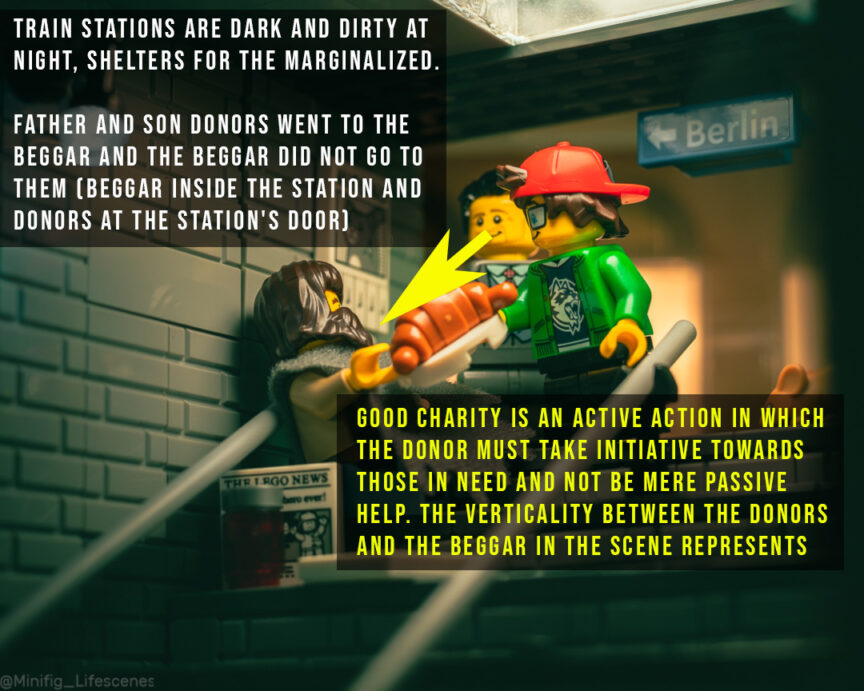
The newspapers, the poster, and the mouse reinforce the dirty and abandoned environment. The “Berlin” sign has an arrow towards the center of the scene, just as the handrails also direct the eye there. The white poster behind the beggar makes the scene more detailed and reduces the empty space on the wall. As in the previous photo, the spotlight style lighting highlights our characters.
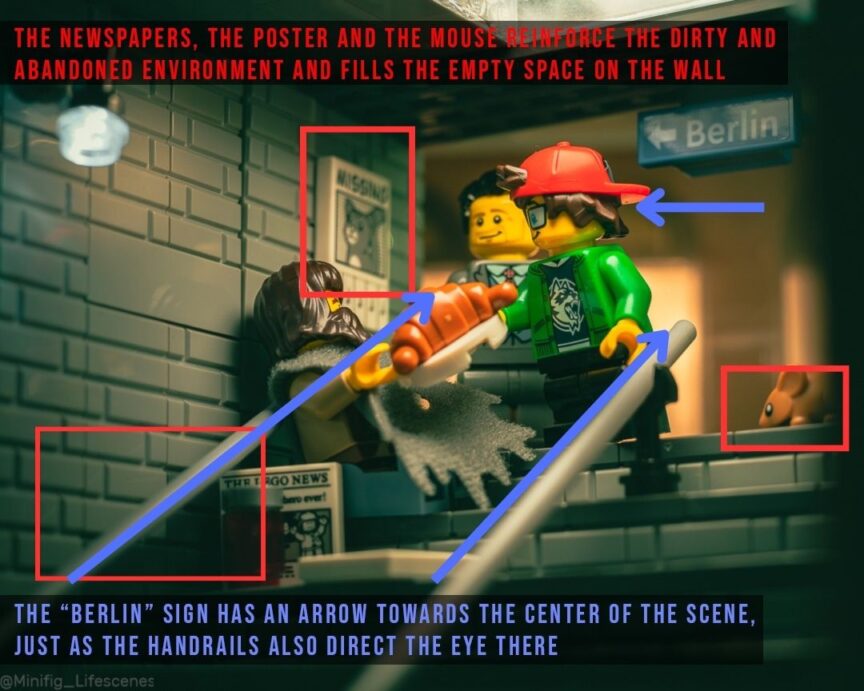
Fourth example
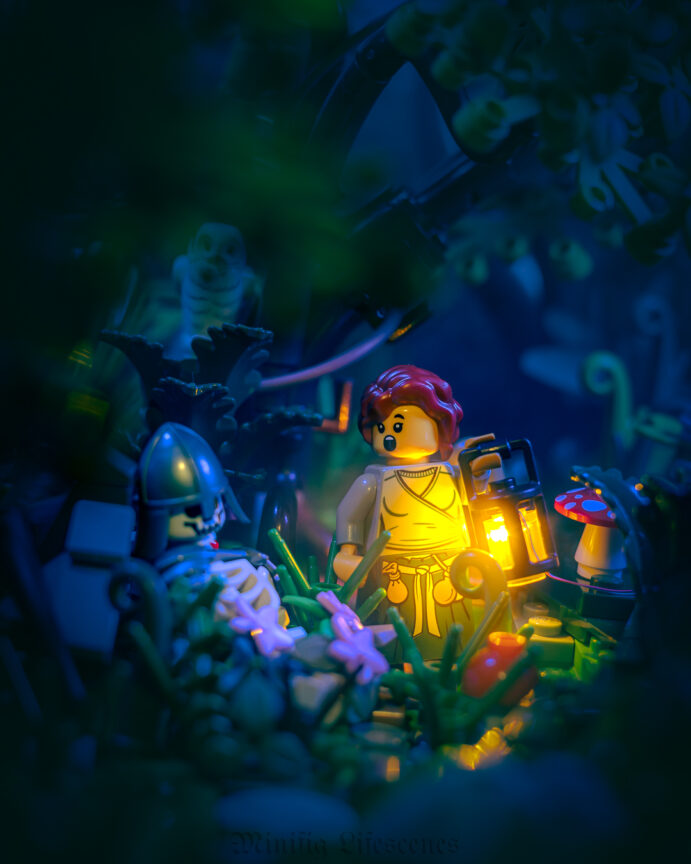
In this last example, I intended to make an image that portrayed, in some way, a clash between contrasts/oppositions, but this clash was more subtle, symbolic, and not so obvious. I thought of some oppositions I could explore: dark/light, death/life, known/unknown.

For death, I chose a skeleton, which is the inexorable end of us all. The contrast of death is life. To represent it, I thought of flowers, herbs, and mushrooms that grow around the skeleton: the death of one provides life for the others.
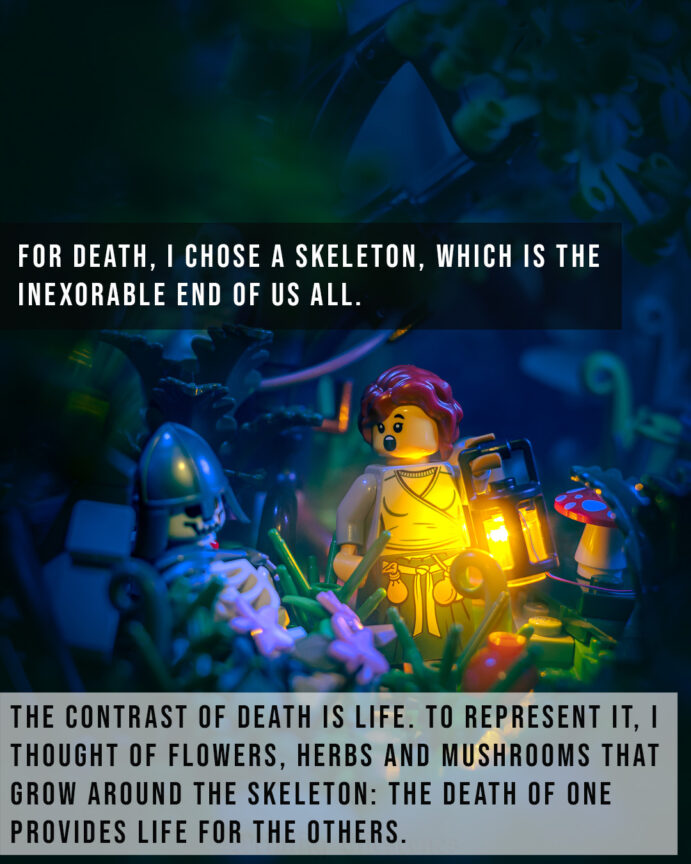
Opposition of darkness and light. Nothing portrays darkness like night. The dense forest reinforces the idea of darkness. The contrast comes from the strong warm light lamp (note that dark blue and warm white are colors that combine very well for night scenes). The lamp illuminates the peasant woman’s path through the darkness of the forest.
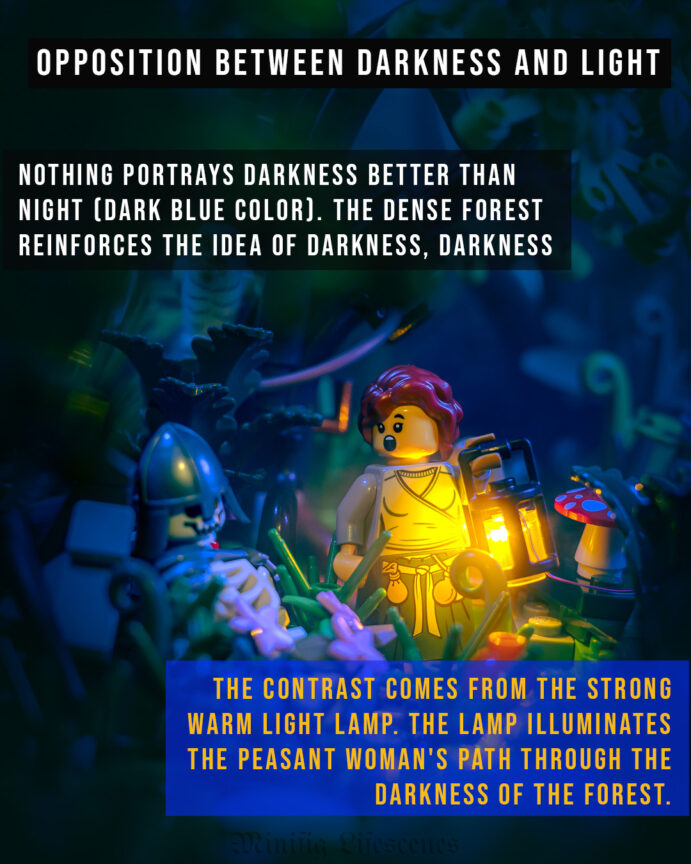
There is another subtle contradiction/opposition here. When choosing a peasant woman, I imagined someone familiar with the forest and who calmly collects herbs or fruits at night. However, this time there was a surprise, the encounter of a skeleton (death/danger), showing that we can never master everything that happens around us. The surprise was portrayed by the peasant woman’s expression and represents the contrast between the known and the unknown.
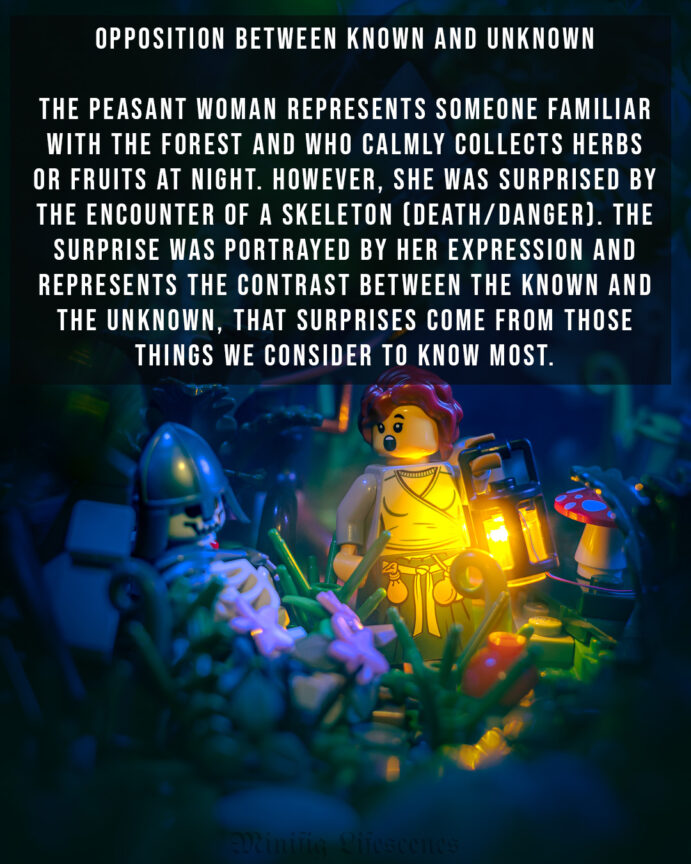
Ultimately, this image aimed to subtly portray the cycle of life as a paradox. The organic matter from the corpse fed the flowers, herbs, and mushrooms. The peasant woman uses these herbs for her food and potions. One day, the peasant woman will also die and will feed other beings on earth. This cycle shows that life and death is a great paradox.
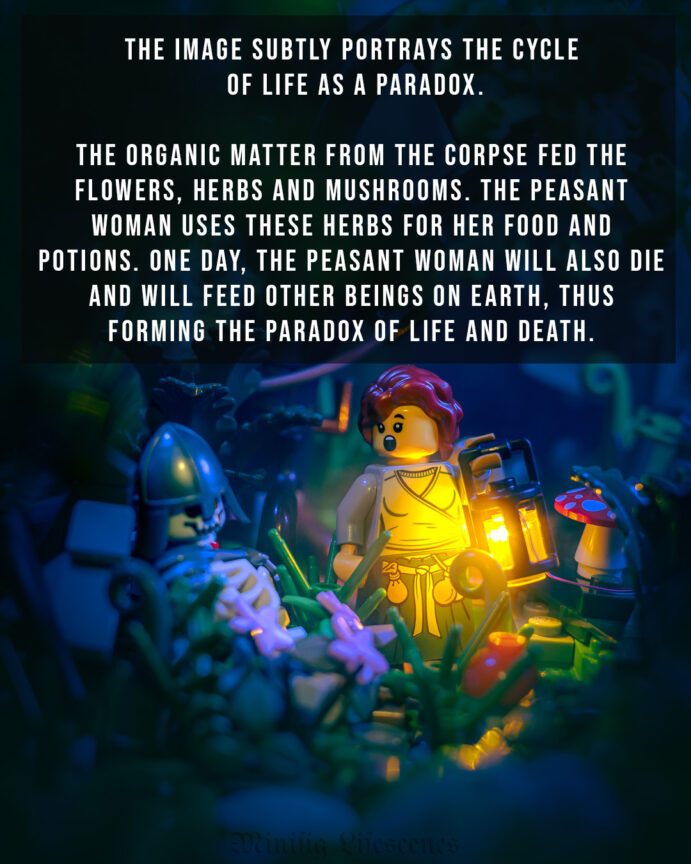
Wrapping up
Well, to finish the proposal for this tip, I want to say that I know that raising the level of our photographs so that they have deeper layers of meaning is extremely difficult. But don’t be discouraged. The vast majority of photographs (especially of Lego) are mere portraits of minifigures.
Taking a dive beyond that can be transformative and reframe your relationship with photography. Think about how many things you would like to say to the world.
Art can be a silent cry for everything we want to say. Contained emotions, teachings, philosophical reveries, etc. It is certainly not an easy job to express yourself in images, but simply becoming aware that we can say a lot with a scene is already transformative. It opens our minds to new possibilities and can give a deeper meaning to a simple hobby.
All 4 photos that I presented to you depict mental processes and emotions that I experienced myself. Producing these photographs took on, to a certain extent, a therapeutic path to opening my heart, whether to happy emotions or difficult moments.
I hope these examples can inspire you and help you open your minds and hearts to the great adventure that can exist within every photograph you make.

0jqo22